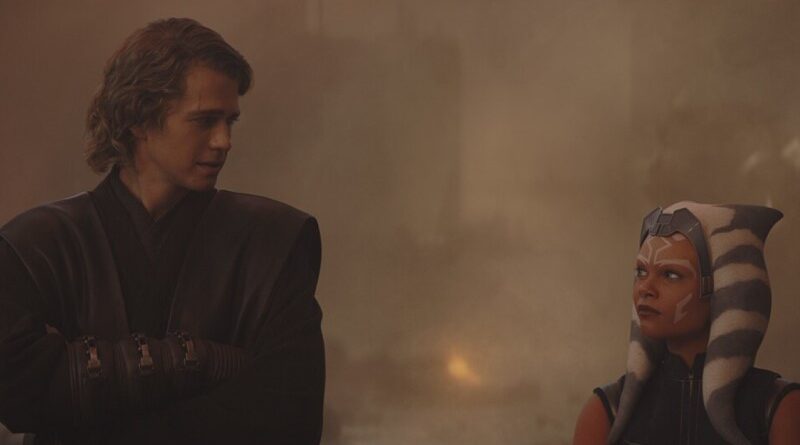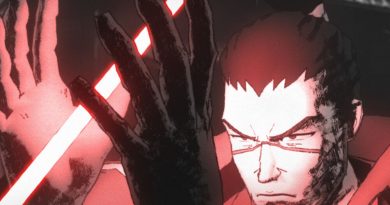Hyperspace Theories: Anakin and Ahsoka Reunite (Sort Of) in AHSOKA’s Belly of the Whale
Tricia Barr and B.J. Priester return for another episode of Hyperspace Theories discussing the Ahsoka Disney+ series, specifically the second act of the story: Part Three “Time to Fly,” Part Four “Fallen Jedi,” and Part Five “Shadow Warrior.” Often Star Wars is at its best when it advances not only the character arcs of its principals, but also the mythology of the franchise, The episodes of Ahsoka, and “Shadow Warrior” especially, mark a great success in that tradition.
As we mentioned in our previous episode discussing the two-part premiere, Ahsoka has excelled at representation and inclusion, particularly compared to Star Wars’ less than stellar historical track record. In late September, the Women’s Committee of the Critic’s Choice Association (CCA) announced that it would be honoring Ahsoka with the Seal of Female Empowerment in Entertainment (SOFEE), which “recognizes outstanding new films and television series that illuminate the female experience and perspective through authentically told female-driven stories.” The press release noted that Ahsoka had achieved “a perfect score in the numerical formula” which evaluates whether nominated projects “have a prominent female character arc, give female characters at least equal screen time to male characters, have female leaders behind the scenes, and pass elements highlighted in the Bechdel test.” Congratulations to Carrie Beck, Dave Filoni, and the other leaders behind Ahsoka for their contributions to making this kind of recognition possible for a Star Wars project.
The second act of Ahsoka places the characterization focus on the titular character and the personal and spiritual journey she undertakes. “Time to Fly” and “Fallen Jedi” reveal the ways in which Ahsoka Tano, despite her age and experience, still faces the emotional legacy of her past and still struggles to follow herself the Jedi lessons she imparts to Sabine. In “Shadow Warrior” her near-death experience compels her to face her deepest traumas and fears – and to finally truly confront her feelings toward former Master, Anakin Skywalker, and his fate as Darth Vader, and what it means for Ahsoka to have been trained by him. After her rescue and return to land on Seatos, she has rediscovered her true self and made the transition, inspired by Tolkein’s Gandalf, from Ahsoka the Gray to Ahsoka the White. In the Hero’s Journey monomyth described by Joseph Campbell, a recurring topic on Hyperspace Theories, the Belly of the Whale marks a key metamorphosis from the hero’s ordinary existence to their extraordinary adventure. For Ahsoka, her ascension to her Wizard’s Journey requires such a transformation – and its culmination is indicated, literally, by her passage into the open mouth of a gigantic, ancient purgill.
These episodes of Ahsoka also present interesting perspectives on the Force, and what it means to be a Jedi, through other characters including Sabine, Hera, Jacen Syndulla, Huyang, and Baylan Skoll. All of these ideas are juxtaposed against Ahsoka’s concurrent personal journey, and all of them pay off in the third act of the series. Check back soon for our next episode of Hyperspace Theories analyzing those episodes in depth.
Related Links:
- “AHSOKA” to receive the Seal of Female Empowerment in Entertainment (SOFEE) (Critic’s Choice Association; Sep. 24, 2023)
Contact Information:
- Hyperspace Theories: Twitter @HyperspacePod
- Tricia Barr: Twitter @FANgirlcantina; email Tricia@fangirlblog.com
- B.J. Priester: Twitter @RedPenofLex; email Lex@fangirlblog.
The Ahsoka series premiered and aired on Disney+ during the concurrent ongoing strikes against Disney and other major Hollywood studios by unions representing the writers (WGA) and actors (SAG-AFTRA) who are indispensable to their productions. Accordingly, neither Filoni nor any of the actors in Ahsoka could participate in promotional interviews or other marketing for the series (although they appear in material previously recorded, such as interviews at Star Wars Celebration in April, that is shared by Disney or entertainment journalists). Aside from its value in raising the visibility of the series to the prospective audience, such interviews with talent often provide fascinating insight into the storytelling process, characterization and motivations, and the themes and values underlying a series. We are disappointed that the studios have denied the talent the opportunity to participate in the excitement of the series launch, and the fans and audience the ability to share in their enthusiasm and learn from it, through their unwillingness to agree to reasonable terms relating to changing technology, shifts in production and distribution within the industry, and a fair sharing of billions of dollars in global profits with those who make those profits possible in the first place. Despite the ongoing strikes, the unions have not called for a boycott of the studios: they encourage fans and audience to watch newly released films and series (to demonstrate their value and profitability) and have clarified that non-promotional activities such as reviews, criticism, and analysis are not inconsistent with the terms of the strike. At FANgirl Blog and Hyperspace Theories, we intend to discuss Star Wars (and other projects from the struck studios) in solidarity with the unions and in conformity with their approved official guidance.
- Hyperspace Theories: ANDOR’s Point of View - August 13, 2025
- Hyperspace Theories: Bad Luck Ghorman - June 2, 2025
- Hyperspace Theories: One Year Later as ANDOR Kicks Off Season Two - May 15, 2025










